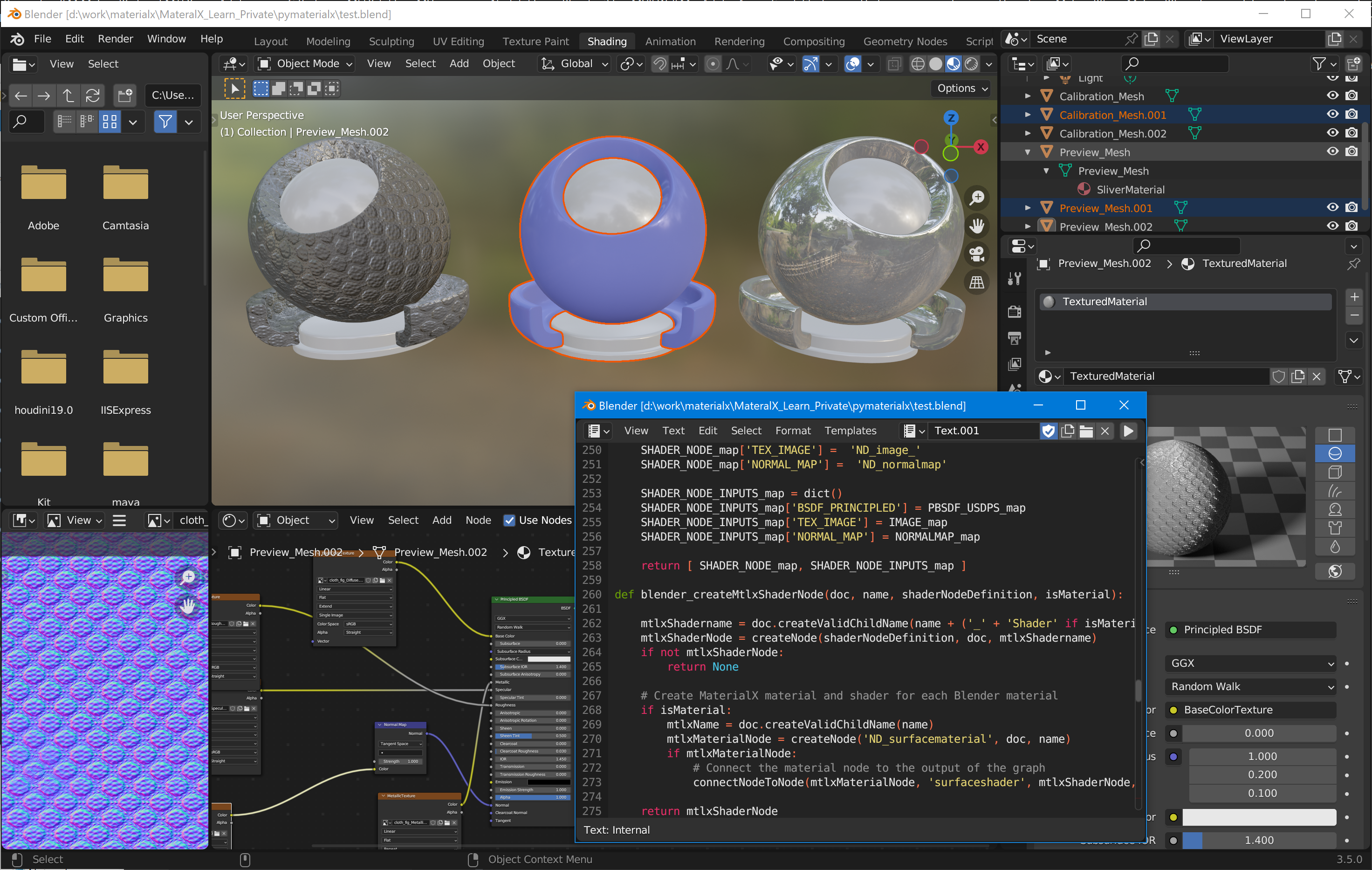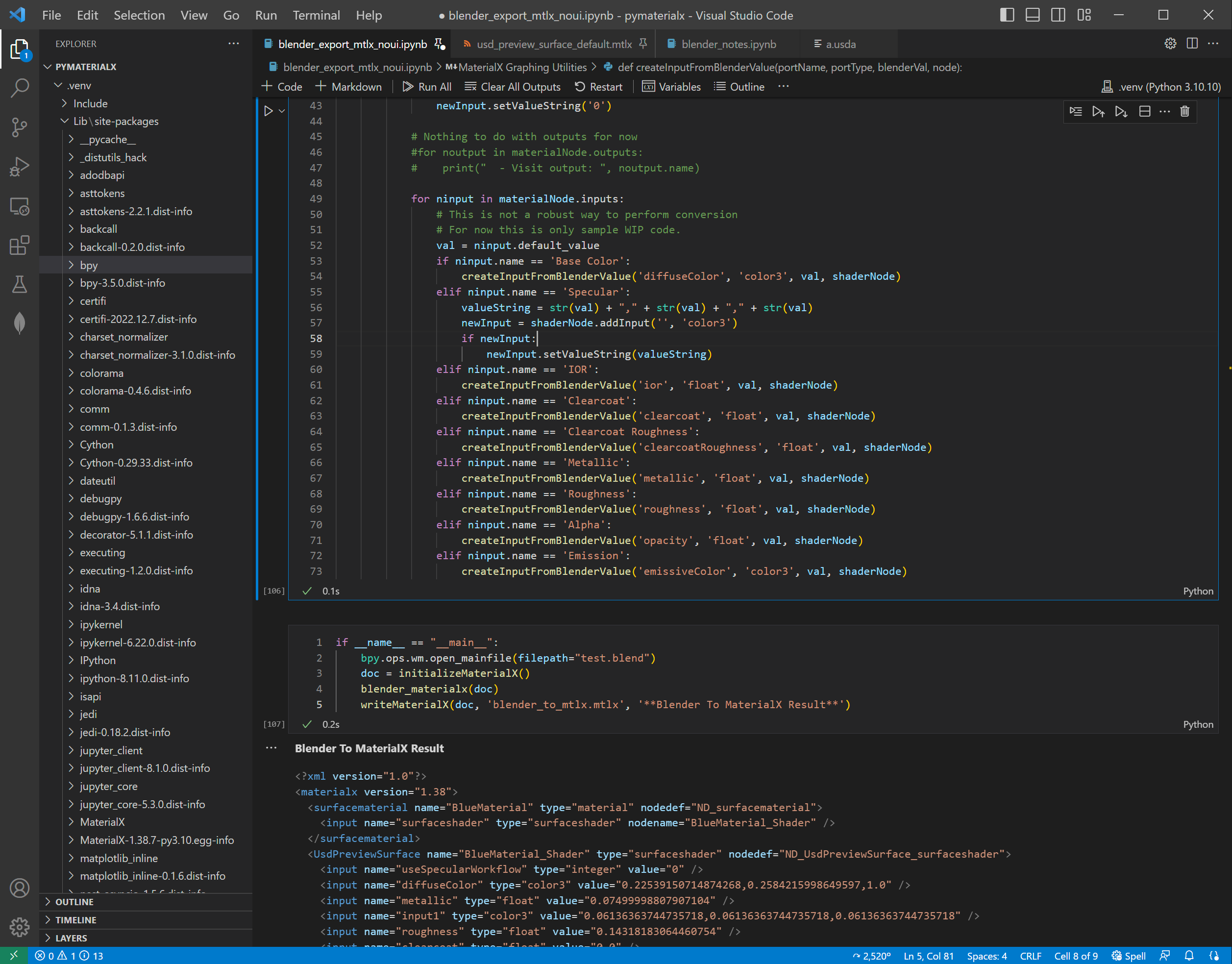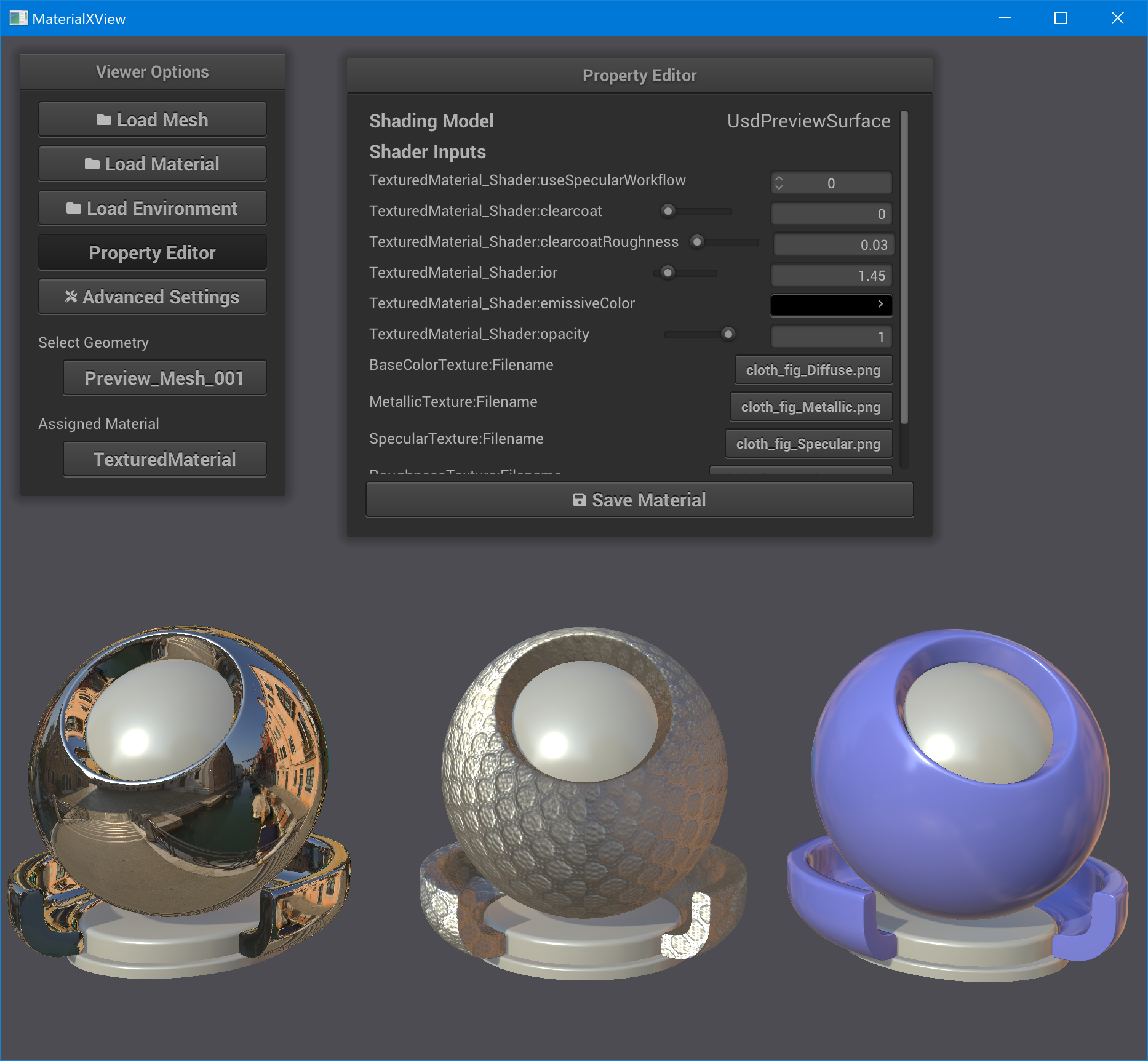Blender and MaterialX¶
In this notebook, we take a look at MaterialX export from an application -- in this case Blender.
The key items covered are:
Discovery of MaterialX package and version within an application.
Current bespoke conversion via code in lieu of any data driven option.
Recording the on-going progression of MaterialX integration into Blender as 3.5 is the first default inclusion of MaterialX. That is, this notebook will be updated as new versions of Blender come out with enhanced MaterialX support. This will include how to use custom MaterialX libraries for Blender nodes when available. See the Libraries / Definitions notebook on current library integrations
The Python MaterialX module which is available as part of the distribution as of Blender 3.5.
This can be found roughly here relative to the install location:
<install location>/Blender Foundation/Blender 3.5/3.5/python/lib/site-packages/MaterialX
The logic presented shows how usage of custom nodes can be converted back to a "standard" shader node representation (in this case MaterialX but USD could be another target). Native applications nodes such as found in Blender are not considered "standard". Naturally the long term ideal is that a MaterialX nodes are natively represented in an application like Blender in
which case something like an export / import process is "trivial".
The notebook thus shows the "fragility" of logic built on top of node and value types on one end, but it
does reuse of MaterialX node graph utilities in mxutils/mxnodegraph (See the
Nodegraph notebook)
Plug-ins such as AMD's ProRender plug-in which includes native MaterialX nodes is a full integration with
complete exporter code that can found here.
The logic found here is however detached from any particular plug-in so can also be used as "starter code" if desired.
The code can be run from within Blender itself or standalone if the user installs the Blender Python package
Note that:
- The minimal Python version is 3.10. This is built with Blender which is in progress but is not currently a Python version which is built as part of the MaterialX Release distribution.
- The MaterialX version is 1.38.6 at time of writing.
As MaterialX support in Blender is in progress, so the only workflow
that will be shown is to target the existing Principal Material as
export to UsePreviewSurface to avoid writing a lot of code targeted at the short term.
Target: USDPreviewSurface¶
<UsdPreviewSurface name="SR_default" type="surfaceshader">
<input name="diffuseColor" type="color3" value="0.18, 0.18, 0.18" />
<input name="emissiveColor" type="color3" value="0, 0, 0" />
<input name="useSpecularWorkflow" type="integer" value="0" />
<input name="specularColor" type="color3" value="0, 0, 0" />
<input name="metallic" type="float" value="0" />
<input name="roughness" type="float" value="0.5" />
<input name="clearcoat" type="float" value="0" />
<input name="clearcoatRoughness" type="float" value="0.01" />
<input name="opacity" type="float" value="1" />
<input name="opacityThreshold" type="float" value="0" />
<input name="ior" type="float" value="1.5" />
<input name="normal" type="vector3" value="0, 0, 1" />
<input name="displacement" type="float" value="0" />
<input name="occlusion" type="float" value="1" />
</UsdPreviewSurface>
Integration Targets¶
Code shown here can be executed within Blender itself as shown below.

or within Visual Studio Code.

With the results available to use for any MaterialX integration such as MaterialXView below.

Blender Setup¶
The Blender Python package is imported for usage after installation.
# %%
# Import blender package
import bpy
print('Blender Package Version:', bpy.app.version_string)
A module that was compiled using NumPy 1.x cannot be run in
NumPy 2.0.1 as it may crash. To support both 1.x and 2.x
versions of NumPy, modules must be compiled with NumPy 2.0.
Some module may need to rebuild instead e.g. with 'pybind11>=2.12'.
If you are a user of the module, the easiest solution will be to
downgrade to 'numpy<2' or try to upgrade the affected module.
We expect that some modules will need time to support NumPy 2.
Traceback (most recent call last): File "<frozen runpy>", line 198, in _run_module_as_main
File "<frozen runpy>", line 88, in _run_code
File "C:\Users\home\AppData\Roaming\Python\Python311\site-packages\ipykernel_launcher.py", line 18, in <module>
app.launch_new_instance()
File "C:\Users\home\AppData\Roaming\Python\Python311\site-packages\traitlets\config\application.py", line 1075, in launch_instance
app.start()
File "C:\Users\home\AppData\Roaming\Python\Python311\site-packages\ipykernel\kernelapp.py", line 739, in start
self.io_loop.start()
File "C:\Users\home\AppData\Roaming\Python\Python311\site-packages\tornado\platform\asyncio.py", line 205, in start
self.asyncio_loop.run_forever()
File "C:\Users\home\AppData\Local\Programs\Python\Python311\Lib\asyncio\base_events.py", line 604, in run_forever
self._run_once()
File "C:\Users\home\AppData\Local\Programs\Python\Python311\Lib\asyncio\base_events.py", line 1909, in _run_once
handle._run()
File "C:\Users\home\AppData\Local\Programs\Python\Python311\Lib\asyncio\events.py", line 80, in _run
self._context.run(self._callback, *self._args)
File "C:\Users\home\AppData\Roaming\Python\Python311\site-packages\ipykernel\kernelbase.py", line 545, in dispatch_queue
await self.process_one()
File "C:\Users\home\AppData\Roaming\Python\Python311\site-packages\ipykernel\kernelbase.py", line 534, in process_one
await dispatch(*args)
File "C:\Users\home\AppData\Roaming\Python\Python311\site-packages\ipykernel\kernelbase.py", line 437, in dispatch_shell
await result
File "C:\Users\home\AppData\Roaming\Python\Python311\site-packages\ipykernel\ipkernel.py", line 362, in execute_request
await super().execute_request(stream, ident, parent)
File "C:\Users\home\AppData\Roaming\Python\Python311\site-packages\ipykernel\kernelbase.py", line 778, in execute_request
reply_content = await reply_content
File "C:\Users\home\AppData\Roaming\Python\Python311\site-packages\ipykernel\ipkernel.py", line 449, in do_execute
res = shell.run_cell(
File "C:\Users\home\AppData\Roaming\Python\Python311\site-packages\ipykernel\zmqshell.py", line 549, in run_cell
return super().run_cell(*args, **kwargs)
File "C:\Users\home\AppData\Roaming\Python\Python311\site-packages\IPython\core\interactiveshell.py", line 3075, in run_cell
result = self._run_cell(
File "C:\Users\home\AppData\Roaming\Python\Python311\site-packages\IPython\core\interactiveshell.py", line 3130, in _run_cell
result = runner(coro)
File "C:\Users\home\AppData\Roaming\Python\Python311\site-packages\IPython\core\async_helpers.py", line 128, in _pseudo_sync_runner
coro.send(None)
File "C:\Users\home\AppData\Roaming\Python\Python311\site-packages\IPython\core\interactiveshell.py", line 3334, in run_cell_async
has_raised = await self.run_ast_nodes(code_ast.body, cell_name,
File "C:\Users\home\AppData\Roaming\Python\Python311\site-packages\IPython\core\interactiveshell.py", line 3517, in run_ast_nodes
if await self.run_code(code, result, async_=asy):
File "C:\Users\home\AppData\Roaming\Python\Python311\site-packages\IPython\core\interactiveshell.py", line 3577, in run_code
exec(code_obj, self.user_global_ns, self.user_ns)
File "C:\Users\home\AppData\Local\Temp\ipykernel_24068\3502280855.py", line 3, in <module>
import bpy
--------------------------------------------------------------------------- AttributeError Traceback (most recent call last) AttributeError: _ARRAY_API not found
--------------------------------------------------------------------------- ImportError Traceback (most recent call last) ImportError: numpy.core.multiarray failed to import
Blender Package Version: 4.3.0
MaterialX Setup¶
The basic setup imports the MaterialX package and uses additional utilities introduced in other notebooks
for node / nodegraph and file handling.
# %%
# Import MaterialX package
import MaterialX as mx
# Version check
from mtlxutils.mxbase import *
haveVersion1387 = haveVersion(1,38,7)
if not haveVersion1387:
print("** Warning: Recommended version is 1.38.7 for tutorials. Have version: ", mx.__version__)
else:
print('MaterialX Package Version:', mx.__version__)
MaterialX Package Version: 1.39.2
To test for the existence of MaterialX, it is possible to examine the site packages included with Blender.
Blender versions 3.5 and above includes MaterialX so that package would be found. Otherwise, MaterialX
needs to be installed as an extra step. As of 1.38.7, the data libraries are included as part of the MaterialX package
but not be found in Blender 3.5.
Note that it is possible to simplify coding for the 3.5 and higher release by copying over the 1.38.6
librariesfolder from a release into the Blender package location.
Also note that the code is run outside of Blender so will return the package location relative to this notebook.
# %%
# This code needs to be run within Blender to return the appropriate result.
# 1. Find the Blender Python site packages folder
# When run inside Blender a path like this will be returned by default (on Windows)
# ['C:\\Program Files\\Blender Foundation\\Blender 3.5\\3.5\\python',
# 'C:\\Program Files\\Blender Foundation\\Blender 3.5\\3.5\\python\\lib\\site-packages']
import site, os
packages = site.getsitepackages()
foundPackage = False
librariesRoot = ''
materialXRoot = ''
for package in packages:
pythonRoot = mx.FilePath(package)
# 2. Find the location of the MaterialX package
materialXRoot = pythonRoot / mx.FilePath('MaterialX')
if os.path.exists(materialXRoot.asString()):
foundPackage = True
librariesRoot = materialXRoot / "libraries"
if not os.path.exists(librariesRoot.asString()):
librariesRoot = ''
break
if foundPackage:
print('MaterialX package location:', materialXRoot.asString())
if librariesRoot:
print('Default data libraries found at:', librariesRoot.asString())
else:
print('Default data libraries are not part of the MaterialX package.')
else:
print('MaterialX package not found')
MaterialX package location: C:\Users\home\AppData\Local\Programs\Python\Python311\Lib\site-packages\MaterialX Default data libraries found at: C:\Users\home\AppData\Local\Programs\Python\Python311\Lib\site-packages\MaterialX\libraries
An additional utility is added to write the output to file and Markdown display.
# %%
# Import graph and file utiities
from mtlxutils.mxnodegraph import MtlxNodeGraph as mxg
from mtlxutils.mxfile import MtlxFile as mxf
# For Markdown output display
from IPython.display import display_markdown
def writeMaterialX(doc, filePath, markdown_title):
"""
Simple utility to write a document to a Markdown section
and or a to disk.
"""
writeOptions = mx.XmlWriteOptions()
writeOptions.writeXIncludeEnable = False
writeOptions.elementPredicate = mxf.skipLibraryElement
if markdown_title:
documentContents = mx.writeToXmlString(doc, writeOptions)
display_markdown(markdown_title, raw=True)
display_markdown('```xml\n' + documentContents + '\n```\n', raw=True)
if filePath:
mx.writeToXmlFile(doc, filePath, writeOptions)
Blender to MaterialX Conversion Utilities¶
A series of bespoke utilities have been written to handle Blender based on the current version (3.5) used.
Blender Value to MaterialX Node Input¶
blender_createMtlxInput(): Handles creating an named input port on given shader node given the Blender value.There is no explicit runtime type identification (
RTTI) thus type is derived based MaterialX definition port type, and Python type.Blender vector type length is sanity checked and clamped against MaterialX vector types.
Blender floats are replicated if the MaterialX port is a vector.
floatToStr()is a simple utility to format string output for floats with fixed precision
# %%
def floatToStr(val):
"""
Emit formatted float value to string
"""
return f"{val:.4g}"
def blender_createMtlxInput(portName, blenderVal, node, nodedef):
"""
Creat input on shader node based on blender value
"""
#print('------- add input: ', portName)
nodedefInput = nodedef.getInput(portName)
if not nodedefInput:
return
valueLen = dict()
valueLen['color3'] = 3
valueLen['color4'] = 4
valueLen['vector2'] = 2
valueLen['vector3'] = 3
valueLen['vector4'] = 4
valueLen['float'] = 1
portType = nodedefInput.getType()
# Check Python type to get string values
# * Use nodedef port type to clamp vector inputs. For example
# * Blender colors can be 4 float (rgba) in length, but the MaterialX port is only 3 float (rgb).
# * Blender float can map to a MaterialX vector. The float is replicated as needed
valueString = ''
valueLength = valueLen[portType]
if isinstance(blenderVal, float):
if valueLength == 1:
valueString = floatToStr(blenderVal)
else:
blenderValString = []
for i in range(0,valueLength):
blenderValString.append(floatToStr(blenderVal))
valueString = ','.join(blenderValString)
elif isinstance(blenderVal, int):
valueString = str(blenderVal)
elif isinstance(blenderVal, str):
valueString = str(blenderVal)
else:
if len(blenderVal) in (2,3,4):
blenderValString = []
for i, c in enumerate(blenderVal):
if i < valueLength:
blenderValString.append(floatToStr(blenderVal[i]))
valueString = ','.join(blenderValString)
if len(valueString):
newInput = node.addInput(portName, portType)
if newInput:
newInput.setValueString(valueString)
return newInput
Mapping of Blender Nodes / Inputs to MaterialX¶
blender_init_node_dictionary()is used to create a dictionary (mapping) from specific Blender nodes to MaterialX nodes. There appears to be no schema to define Blender nodes so hard-coded port names use for port mapping.blender_createMtlxShaderNode()is used to create a MaterialX shader node from a Blender shader node. As a Blender Material maps to a MaterialX shader, we create two nodes when a material is encountered. A proper mapping ofBlender Material Outputnodes is not performed here as these best match a MaterialX material node.
# %%
def blender_init_node_dictionary(targetBSDF):
# Manual name mapping from Blender BSDF to USD Preview Surface
PBSDF_USDPS_map = dict()
PBSDF_USDPS_map['Base Color'] = 'diffuseColor'
PBSDF_USDPS_map['Specular'] = 'specularColor'
PBSDF_USDPS_map['IOR'] = 'ior'
PBSDF_USDPS_map['Clearcoat'] = 'clearcoat'
PBSDF_USDPS_map['Clearcoat Roughness'] = 'clearcoatRoughness'
PBSDF_USDPS_map['Metallic'] = 'metallic'
PBSDF_USDPS_map['Roughness'] = 'roughness'
PBSDF_USDPS_map['Alpha'] = 'opacity'
PBSDF_USDPS_map['Emission'] = 'emissiveColor'
PBSDF_USDPS_map['Normal'] = 'normal'
IMAGE_map = dict()
NORMALMAP_map = dict()
# Mapping from Blender nodes to MaterialX node definitions
SHADER_NODE_map = dict()
SHADER_NODE_map['BSDF_PRINCIPLED'] = targetBSDF
SHADER_NODE_map['TEX_IMAGE'] = 'ND_image_'
SHADER_NODE_map['NORMAL_MAP'] = 'ND_normalmap'
SHADER_NODE_INPUTS_map = dict()
SHADER_NODE_INPUTS_map['BSDF_PRINCIPLED'] = PBSDF_USDPS_map
SHADER_NODE_INPUTS_map['TEX_IMAGE'] = IMAGE_map
SHADER_NODE_INPUTS_map['NORMAL_MAP'] = NORMALMAP_map
return [ SHADER_NODE_map, SHADER_NODE_INPUTS_map ]
def blender_createMtlxShaderNode(doc, name, shaderNodeDefinition, isMaterial):
mtlxShadername = name + ('_' + 'Shader' if isMaterial else '')
mtlxShaderNode = mxg.addNode(doc, shaderNodeDefinition, mtlxShadername)
if not mtlxShaderNode:
return None
# Create MaterialX material and shader for each Blender material
if isMaterial:
mtlxMaterialNode = mxg.addNode(doc, 'ND_surfacematerial', name)
if mtlxMaterialNode:
# Connect the material node to the output of the graph
mxg.connectNodeToNode(mtlxMaterialNode, 'surfaceshader', mtlxShaderNode, '')
return mtlxShaderNode
Main Blender to MaterialX Converter¶
The main logic finds all root material nodes and converts that node and any directly connected upstream Blender Texture Image node, or Normal Map node. This is not in any way meant to be a full graph traverser, but there should be sufficient base logic to be able to create such a traverser.
# %%
def blender_connectImageNode(doc, SHADER_NODE_map, mtlxInput, blenderNode):
nodeDefinition = SHADER_NODE_map['TEX_IMAGE']
nodeDefinition = nodeDefinition + mtlxInput.getType()
mtxImageNode = blender_createMtlxShaderNode(doc, blenderNode.label, nodeDefinition, False)
# Connect input to new node
if mtxImageNode:
imagePath = ''
if blenderNode.image:
imagePath = blenderNode.image.filepath_from_user()
fileInput = mtxImageNode.addInput('file', 'filename')
fileInput.setValueString(imagePath)
mxg.connectNodeToNode(mtlxInput.getParent(), mtlxInput.getName(), mtxImageNode, '')
return mtxImageNode
def blender_connectNormalMapNode(doc, SHADER_NODE_map, mtlxInput, blenderNode):
"""
Create a MaterialX normal map node from a Blender node
Connected the new node to an downstream input
"""
nodeDefinition = SHADER_NODE_map['NORMAL_MAP']
mtxNormalMap = blender_createMtlxShaderNode(doc, blenderNode.label, nodeDefinition, False)
mxg.connectNodeToNode(mtlxInput.getParent(), mtlxInput.getName(), mtxNormalMap, '')
return mtxNormalMap
def blender_getUpstreamNode(blenderInput):
if not blenderInput:
return None
link = blenderInput.links[0] if blenderInput.links else None
if link and link.is_valid:
return link.from_node
return None
def blender_materialx(doc, shaderNodeMappings):
"""
Simple Export of a few Blender nodes to MaterialX material nodes + shaders
"""
SHADER_NODE_map = shaderNodeMappings[0]
SHADER_NODE_INPUTS_map = shaderNodeMappings[1]
shaderType = 'BSDF_PRINCIPLED'
for m in bpy.data.materials:
if not m.node_tree:
continue
# Find the default material node type
materialNode = None
for node in m.node_tree.nodes:
if node.type == shaderType:
materialNode = node
break
if materialNode:
# Creat a corresponding MaterialX material / shader node
shaderNodeDefinition = SHADER_NODE_map[shaderType]
if not shaderNodeDefinition:
#print('Skip handling of node', materialNode)
continue
mtlxShaderNode = blender_createMtlxShaderNode(doc, m.name, shaderNodeDefinition, shaderType == 'BSDF_PRINCIPLED')
if not mtlxShaderNode:
continue
mtlxShaderNodeDef = mtlxShaderNode.getNodeDef()
# Nothing to do with outputs for now
#for noutput in materialNode.outputs:
# print(" - Visit output: ", noutput.name)
#print('Add inputs to node: ', mtlxShaderNode.getNamePath())
PBSDF_USDPS_map = SHADER_NODE_INPUTS_map[shaderType]
for ninput in materialNode.inputs:
if not ninput.name in PBSDF_USDPS_map:
#print('-- Skip translating input: ', ninput.name)
continue
# Add in inputs
val = ninput.default_value
portName = PBSDF_USDPS_map[ninput.name]
newInput = None
if portName:
newInput = blender_createMtlxInput(portName, val, mtlxShaderNode, mtlxShaderNodeDef)
if portName == 'normal':
newInput.setValueString('0,0,1')
# Check for upstream connections
if not newInput:
continue
connectedNode = blender_getUpstreamNode(ninput)
if connectedNode:
mtxNormalMap = None
# Add a MaterialX normal map node for each Blender normal map node
if connectedNode.type == 'NORMAL_MAP':
mtxNormalMap = blender_connectNormalMapNode(doc, SHADER_NODE_map, newInput, connectedNode)
# Traverse upstream
colorInput = connectedNode.inputs['Color']
if colorInput:
connectedNode = blender_getUpstreamNode(colorInput)
# Add an MaterialX image node for each Blender texture image node
mtxImageNode = None
if connectedNode.type == 'TEX_IMAGE':
mtxImageNode = blender_connectImageNode(doc, SHADER_NODE_map, newInput, connectedNode)
# Connect normal map and image node if both found
if mtxNormalMap and mtxImageNode:
mxg.connectNodeToNode(mtxNormalMap, 'normal', mtxImageNode, '')
# %%
if __name__ == "__main__":
bpy.ops.wm.open_mainfile(filepath="data/test.blend")
doc, libFiles, status = mxf.createWorkingDocument()
shaderNodeMap = blender_init_node_dictionary('ND_UsdPreviewSurface_surfaceshader')
blender_materialx(doc, shaderNodeMap)
writeMaterialX(doc, 'data/blender_to_mtlx.mtlx', '**Blender To MaterialX Result**')
Error: Cannot read file "D:\work\materialx\MaterialX_Learn\pymaterialx\data\test.blend": No such file or directory
--------------------------------------------------------------------------- RuntimeError Traceback (most recent call last) Cell In[8], line 3 1 # %% 2 if __name__ == "__main__": ----> 3 bpy.ops.wm.open_mainfile(filepath="data/test.blend") 4 doc, libFiles, status = mxf.createWorkingDocument() 5 shaderNodeMap = blender_init_node_dictionary('ND_UsdPreviewSurface_surfaceshader') File ~\AppData\Local\Programs\Python\Python311\Lib\site-packages\bpy\4.3\scripts\modules\bpy\ops.py:109, in _BPyOpsSubModOp.__call__(self, *args, **kw) 107 ret = _op_call(self.idname_py(), kw, C_exec, C_undo) 108 else: --> 109 ret = _op_call(self.idname_py(), kw) 111 if 'FINISHED' in ret and context.window_manager == wm: 112 _BPyOpsSubModOp._view_layer_update(context) RuntimeError: Error: Cannot read file "D:\work\materialx\MaterialX_Learn\pymaterialx\data\test.blend": No such file or directory
Diagram of Blender Graph¶
Using the Mermaid graph utilities we can visualize the resulting graph:
from mtlxutils.mxtraversal import *
from mtlxutils.mxfile import *
# Load in document and create a Mermaid graph
doc, libFiles, status = MtlxFile.createWorkingDocument()
mx.readFromXmlFile(doc, 'data/blender_to_mtlx.mtlx')
roots = doc.getMaterialNodes()
graph = MtlxMermaid.generateMermaidGraph(roots, 'LR')
from IPython.display import display_markdown
strgraph = '```mermaid\n'
for line in graph:
if line:
strgraph = strgraph + line + '\n'
strgraph = strgraph + '```\n'
display_markdown(strgraph, raw=True)
graph LR;
BlueMaterial_Shader([BlueMaterial_Shader]) --".surfaceshader"--> BlueMaterial([BlueMaterial])
DefaultMaterial_Shader([DefaultMaterial_Shader]) --".surfaceshader"--> DefaultMaterial([DefaultMaterial])
Normal_Map_Image([Normal_Map_Image]) --".normal"--> TexturedMaterial_Shader([TexturedMaterial_Shader])
MetallicTexture([MetallicTexture]) --".metallic"--> TexturedMaterial_Shader([TexturedMaterial_Shader])
RoughnessTexture([RoughnessTexture]) --".roughness"--> TexturedMaterial_Shader([TexturedMaterial_Shader])
TexturedMaterial_Shader([TexturedMaterial_Shader]) --".surfaceshader"--> TexturedMaterial([TexturedMaterial])
SliverMaterial_Shader([SliverMaterial_Shader]) --".surfaceshader"--> SliverMaterial([SliverMaterial])
BaseColorTexture([BaseColorTexture]) --".diffuseColor"--> TexturedMaterial_Shader([TexturedMaterial_Shader])
%% Subgraphs
%% Style
style SliverMaterial fill:#0C0, color:#111
style TexturedMaterial fill:#0C0, color:#111
style DefaultMaterial fill:#0C0, color:#111
style BlueMaterial fill:#0C0, color:#111